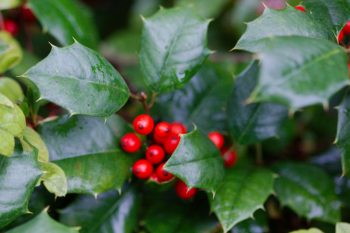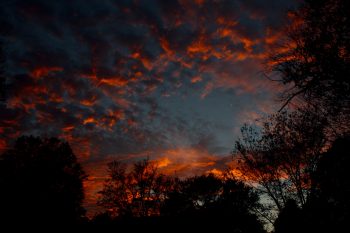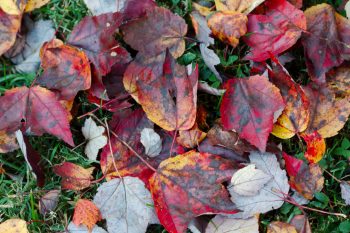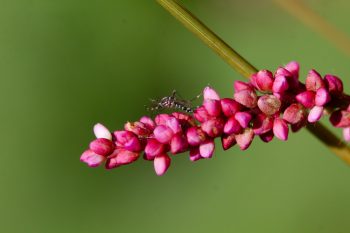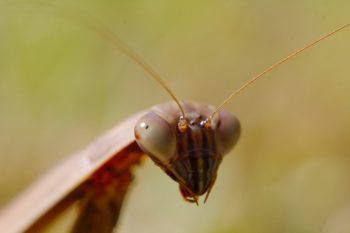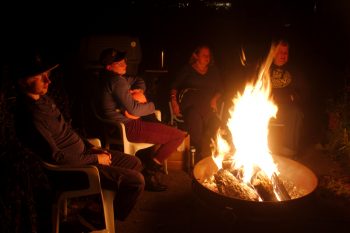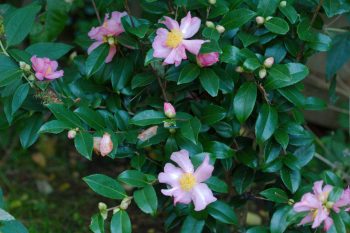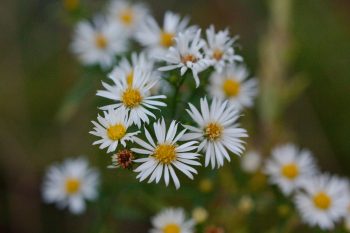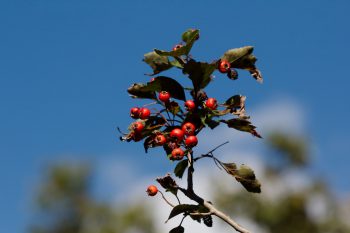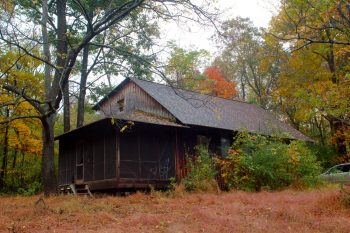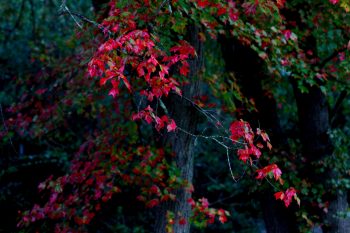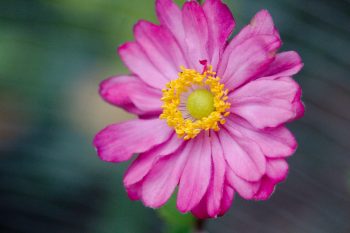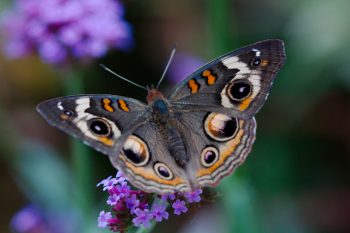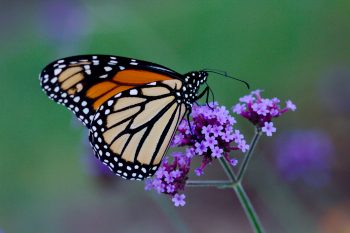We have a really nice crop of holly berries on the tree in front of our house this fall. The squirrels are constantly in this tree and the ground underneath it, including the front walk, is constantly littered with pieces of berry and the occasional leaf. The robins also like them and generally, at some point in the winter, we’ll look out and they will be systematically devouring them. There is another holly at the corner of the house and the robins have found that one and were up in it the other day. So far this one has just been the squirrels, though.
Holly Berries
Saint Mary’s Church and Graveyard
We had some free time this afternoon so we drove to downtown Rockville and wondered around the St. Mary’s Church graveyard for a while. I took a picture of F. Scott and Zelda Fitzgerald’s grave marker (and their daughter, Francis Scott Fitzgerald Smith). It’s a pretty little graveyard, if you like that sort of thing. We do. I took some pictures of the church reflected in the mostly glass building at Jefferson Plaza across the pike. I also took some general views of the graveyard. I figured for my post, however, I’d use this one, showing both the older church building—now known as the Chapel of Our Lady—and the new domed building, dating from the 1960s. The parish was established in 1813 with the land being bought for $300 and the initial church building costing about $4,000. It has obviously seen a few changes over the years. The old church building was scheduled for demolition but was saved and became the chapel that it is today. I’m glad it was saved, as it’s a pretty, little church.
Sunset
Sunset is getting earlier each evening now, as autumn marches on. Soon we’ll set out clocks back to real time and it will get dark even earlier. For now, I’m at least done work before it gets dark, but that will change. The clouds this evening promised a really nice sunset and we weren’t disappointed. This is from out back steps, looking between the trees and over the house behind ours. We could have a worse view, I have to admit. It’s good to remember that wherever you live, there are times when it’s as pretty as anywhere else on earth. Well, the sky can be, anyway.
Foggy Morning
I really like fog. I mean, I wouldn’t want to live in a place that was always foggy, I suppose, but we have fog rarely enough that it’s a treat. It makes an ordinary morning scene more atmospheric, I think. This is just an old black cherry tree and some azaleas in the yard next door but the fog makes it look more exotic. I remember particularly foggy mornings in Cambridge. We lived near the river so we got them a bit more often than parts of the town and generally there was less fog by the time we got to school, but I remember days when Ralph and I had to make our way to the bus stop with one hand on the fence to stay on the pavement.
Autumn Leaves
Autumn is here and the trees are turning their autumn colors. The leaves are falling and covering the ground with shades of red, yellow, orange, and eventually brown. This is under the red maple (Acer rubrum) in out back yard. Maples are among some of the best large trees for fall color. I need to walk to the other end of the neighborhood where there is a yard with a nice collection of Japanese maples (Acer palmatum). Those are some of the prettiest trees in our neighborhood, handsome throughout the year but especially nice in the fall.
Orchids on Singapore Dollar Note
From 1967 through 1972, the Singapore one dollar note featured the Orchid Vanda ‘Janet Kaneali’. I really don’t know much about that particular orchid but the genus has about 80 species. They are mostly epiphytic (Per Mirriam Webster, “a plant that derives its moisture and nutrients from the air and rain and grows usually on another plant”). I was a little stumped for what to take a photo of today. I’ve done pretty well getting outdoors most of the year since the Covidian miasma set it, but it didn’t happen today. It won’t be long before it’s dark when I get off work, so this will get harder going forward.
The Female Fellows
After work I drove out to Rocklands, where the Fourth Fellows were gathering for their weekly meal together. I had talked with David yesterday and he said he’d love to have some pictures of them. I took quite a few, including the whole group, but I’m particularly happy with those I got of the six you women in the group. From left to right, they are Thea, Dorothy, Genevieve, Elizabeth, Lydia, and Emily. It was a lovely evening and I was allowed to stay for dinner, which was an added bonus.
Smartweed and Mosquito
Cathy and I walked to the park today and I took a few pictures. This is a very common weed in our area, called Pennsylvania smartweed (Persicaria pensylvanica). I got a bonus in this photograph, of an Asian tiger mosquito (Aedes albopictus). I’m not really a big fan of either, I’ afraid. Weeds are a common problem in our garden and this one shows up without fail. And I don’t know many fans of mosquitoes of any kind. Nevertheless, they both have a sort of beauty that cannot be denied.
Fireside Chat
We had some friends over for dinner on the back patio this evening and I built a nice fire to keep us warm and to provide light when it got dark. Each of us had our own carry-out dinners and we sat relatively far apart. Nevertheless, it was good to be in actual company with others. I think I speak for everyone that it was a really enjoyable evening. From left to right, these are Josh, Julia, Maureen, and Bob. Cathy is out of the picture and of course I was taking it, so I’m out, as well.
Camellia x ‘Winter’s Star’
I bought this camellia, called ‘Winter’s Star’, from Camellia Forest and planted it along the fence at the north end of our back garden. It’s doing well and is coming into bloom. This is a cross between Camellia oleifera and Camellia hiemalis ‘Showa-no-sakae’ and as you can see, it has single, pink flowers and is a fall bloomer. It’s only three or so feet tall at this point, but it should get large enough to be a really striking fall feature in that part of the yard. I bought and planted two other camellias at the same time. These others are both C. japonica and are called ‘Hokkaido Red’ and ‘April Rose’, both spring bloomers.
Fleabane (Erigeron)
Cathy and I took a short walk in the park this afternoon. It’s been cool and damp and it was very pleasant in the woods. I took a few photos, as usual, but nothing particularly spectacular (also as usual). This is a fleabane (Erigeron) of some sort, and pretty common around here. It’s one of the few things still blooming. There were berries on the Amur honeysuckle (Lonicera maackii) as well as on the ornamental pears. When the Bradford pear was first introduced, it didn’t bear fruit because it had no other variety to pollinate its flowers. Over time, there was either enough variation in the genetic makeup or some trees were sold as Bradford that were not. Now they all bear small, round pears.
Hawthorn Berries
Twice in the last couple weeks I’ve gone out to take pictures of these hawthorn berries only to be distracted by a butterfly on the nearby Verbena. Today there were no butterflies, so today’s berry photo will make it onto the blog. This is a variety green hawthorn, Crataegus viridis ‘Winter King’. The green hawthorn is native to the southeastern United States. Although ‘Winter King’ is a more disease-resistant cultivar it still has issues with rust and some of the berries were ruined by that. I have some fungicide that I use on my two dwarf apple trees and next year I’ll probably spray this tree, as well.
The Cabin
In 1964 my parents bought some property in rural Pennsylvania. We’d go there either for the day or camp overnight. Then, in 1974 we built the porch that you see here. Two years later we spent virtually the entire summer there building the cabin. It’s had a new roof put on since then but otherwise, it’s pretty much unchanged. There’s no electricity or running water and the walls have no insulation, so it’s not currently somewhere you’d want to live long term. Still, it’s a great family retreat. Cathy and I don’t officially get Columbus Day off but we took annual leave and went there with Dorothy and six of her friends. It was a bit damp and cool, but really nice to be away from home for a little while.
Red Maple
This red maple in our back yard is turning its spectacular scarlet. It was a wet and cool day and I just went outside to take a few pictures from the back steps. This one is a bit dark but it was a dark, dreary day. The red is certainly nice and the color on this tree is considerably better than some. This hasn’t been the most spectacular fall in terms of color. The bulk of the woods are yellow or a slightly orange or reddish brown but that’s normal. There are, of course, some trees that really stand out with brilliant color but it feels like there are fewer this year than normal. But that’s not a scientific measurement, just a gut feeling.
Anemone hupehensis var. japonica ‘Pamina’
We bought this Japanese anemone last year and it was in a pot over the winter. I planted it this spring and for a while it looked like the rabbits were not going to let it grow or bloom. Eventually I put a fence of hardware cloth around it, which they quickly knocked over. Now it’s staked to the ground with tent pegs and isn’t going anywhere. I’m a little bothered by the background in this, where the hardware cloth gives a regular, if out-of-focus pattern. Anyway, the anemone is quite lovely and I’m pretty happy with it. Hopefully it will get well enough established that we can take down the fence.
Blue Passion Flower and Variegated Yucca
The blue passion flower (Passiflora caerulea) in this photo is the same plant that I photographed in June (see Monday, June 15, 2020). The vine is still blooming very nicely and I particularly like the flower in with the straight, sharp, leaves of this variegated yucca (Yucca gloriosa ‘Variegata’), sometimes known as Spanish dagger. It’s an east coast native although from further south, rather than from here. Nevertheless, it’s hardy as far north as USDA Zone 6. This is a few blocks from our house, with the passion flower happily growing on a mailbox with the yucca at its base.
Persicaria virginiana ‘Painter’s Palette’
I don’t really recommend growing painter’s palette (Persicaria virginiana) unless you have a lot of space and want a natural garden. It has a tendency to spread and is a bit of work to control. We have more than we need and most of the year I’m just about ready to pull it up. This is the time of year I don’t mind it quite so much. There isn’t a lot else in bloom and it provides some color in the border with it’s tiny, red flowers on wispy stalks. We have a lot of it mixed with Verbena bonariensis in the large, central bed in our front garden and the two of them together are pretty nice. The foliage is also interesting, with green alternating with a very pale green and with a reddish, V shape stripe.
Junonia coenia (Common Buckeye)
Just a few days ago I mentioned that we were seeing fewer butterflies in the garden. Then I saw and photographed a painted lady (Vanessa cardui), a red admiral (Vanessa atalanta), a monarch (Danaus plexippus), and today a common buckeye (Junonia coenia), all within just over two weeks. So, the summer is going out strong in terms of butterflies. The common buckeye is not particularly rare here, but we haven’t seen a lot of them this year. It’s a pretty butterfly and quite distinctively marked. Like the recently photographed painted lady and monarch, this one is on the Verbena bonariensis.
Monarch Butterfly (Danaus plexippus)
The late afternoon sun was shining on the hawthorn berries and I took some pictures of them before spotting this monarch butterfly (Danaus plexippus) flitting around the tall verbena (Verbena bonariensis). She flew off for a while but I waited and she came back and I was able to get some pretty nice photos. I figured I can get pictures of the hawthorn again tomorrow. The butterflies are getting to be fewer and fewer, so I want to capture them while I can. We’ve had a pretty steady presence of monarchs this summer, although rarely more than one at a time. This one is in particularly fine shape.

